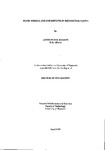FLUID INERTIA AND END EFFECTS IN RHEOMETER FLOWS
| dc.contributor.author | HUGHES, JASON PETER | |
| dc.contributor.other | School of Engineering, Computing and Mathematics | en_US |
| dc.date.accessioned | 2013-09-19T12:53:58Z | |
| dc.date.available | 2013-09-19T12:53:58Z | |
| dc.date.issued | 1998 | |
| dc.identifier | NOT AVAILABLE | en_US |
| dc.identifier.uri | http://hdl.handle.net/10026.1/1889 | |
| dc.description.abstract |
This thesis is concerned with the characterisation of the flow behaviour of inelastic and viscoelastic fluids in steady shear and oscillatory shear flows on commercially available rheometers. The first part of this thesis is concerned with a linear viscoelastic theory to describe the oscillatory shear flow behaviour of fluids on a Weissenberg rheogoniometer. A fluid inertia perturbation analysis is used to produce analytical formulae for correcting complex viscosity data for first and second order fluid inertia effects. In order to validate the perturbation theory we perform a simulation of the oscillatory shear flow behaviour of Newtonian and single element Maxwell fluids on a Weissenberg rheogoniometer. A theoretical prediction of end effects and fluid inertia effects on steady shear viscosity measurements of Newtonian fluids in a recessed concentric cylinder geometry is developed for a GSR controlled stress rheometer and a Weissenberg rheogoniometer. The relevant equations are solved using a perturbation analysis which is valid for low Reynolds number flows. From this theory correction formulae are produced to compensate for end effects and second order fluid inertia effects in steady shear flows on these instruments. End effects and fluid inertia effects are also investigated for power law shear thinning fluids. The final part of the thesis is concerned with a theoretical prediction of the end effect of a recessed concentric cylinder geometry on complex viscosity measurements of a generalised linear viscoelastic fluid. The linear viscoelastic theory is carried out for oscillatory shear flows on a CSR controlled stress rheometer and a Weissenberg rheogoniometer. A fluid inertia perturbation analysis is used to produce analytical formulae to correct complex viscosity data for end effects and second order fluid inertia effects. Numerically simulated oscillatory shear data is used to establish the limitations of the second order fluid inertia correction formulae which include end effects. | en_US |
| dc.language.iso | en | en_US |
| dc.publisher | University of Plymouth | en_US |
| dc.title | FLUID INERTIA AND END EFFECTS IN RHEOMETER FLOWS | en_US |
| dc.type | Thesis | |
| plymouth.version | Full version | en_US |
| dc.identifier.doi | http://dx.doi.org/10.24382/4091 | |
| dc.identifier.doi | http://dx.doi.org/10.24382/4091 |
Files in this item
This item appears in the following Collection(s)
-
01 Research Theses Main Collection
Research Theses Main


